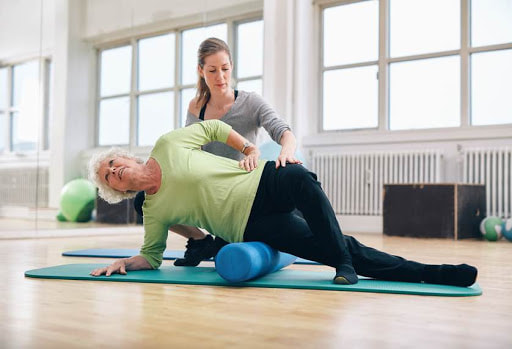 Foam rolling is a form of self-myofascial release technique or SMR for short. To break it down, the fascia in your body is like a large web of connective tissues that covers all your muscles, bones and organs keeping everything tight and connected. The fascia is incredibly strong and also very flexible which allows it to move with your body easily. Just like a muscle the fascia can shorten and become tight and this usually happens due to a muscle not being able to support the extra tension of sustained postures, repetitive movements or altered movements patterns by itself. The fascia comes in to try and help support the muscle and as a result becoming tight itself. Now as the fascia is interconnected throughout the body, issues in one area can cause tightness and pain to develop in other parts of the fascia. What is it? Foam rollers and even trigger balls are pieces of equipment that can be used to assist in releasing fascia or muscle tightness. A foam roller is a cylindrical foam roll that can come in all different sizes and lengths and also have varying degrees of firmness. By lying or pressing your body against the foam roller it creates pressure on that given area which allows you to complete self-myofascial release. This pressure releases the aforementioned tension and tightness within the fascia that can develop. What are the benefits? There is an increase in research being conducted into the benefits of foam rolling and there are many that have been confirmed already. Foam rolling provides an increase in elasticity in the fascia after prolonged periods of inactivity. A lack of movement can also cause the fascia to become tight which is why foam rolling can assist in releasing the fascia allowing it to become more supple again. This will allow your body to move more freely without tightness or restriction. For those of you who experience delayed onset muscle soreness (DOM’s) after an intense workout, foam rolling can be a great tool to assist in your recovery. Foam rolling causes an increase in blood flow to the area where pressure is being applied, which brings with it an increase in oxygen too. This can aid in helping the worked muscles to recover more quickly from your workout and decrease DOM’s. Some studies have shown foam rolling to be more effective than either static or dynamic stretching, at increasing flexibility and range of motion as it assists in lengthening the muscle. It provides an alternative to stretching that can reach and target the fascia in your body differently. Stretching a muscle does not have the same ability as foam rolling to be able to penetrate the muscle and reach the inner fascia holding all your muscle fibres together. Tips to get started It all sounds pretty great right! So how can you get started? Firstly, you will need to get a foam roller. Once you have acquired one you can select a muscle group to work on and then simply begin applying pressure to this area by laying on top of the foam roller and using your body weight as force. Now you wouldn’t be blamed for thinking that the more pressure applied the better release… But this isn’t actually true! You can get almost the same benefits from applying smaller amounts of pressure to the target muscles. You then want to start rolling slowly along the desired muscle group, ideally for around 60 seconds. When foam rolling it is normal to feel a slight amount of pain when targeting muscle groups that are tight, but it can be helpful to roll around the areas that is particularly painful first as this can help to release that area initially. Whether you are new to fitness, you’ve been training for a while or even if you find that you get tight from periods of inactivity, foam rolling can be a useful addition to add into your schedule. By Aleisha Michael Accredited Exercise Physiologist
0 Comments
Your comment will be posted after it is approved.
Leave a Reply. |
AuthorSLisa Parkinson Archives
July 2024
Categories
All
|

 RSS Feed
RSS Feed